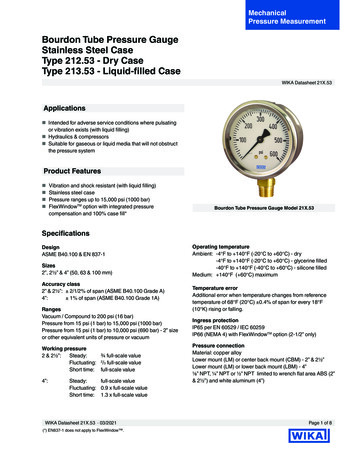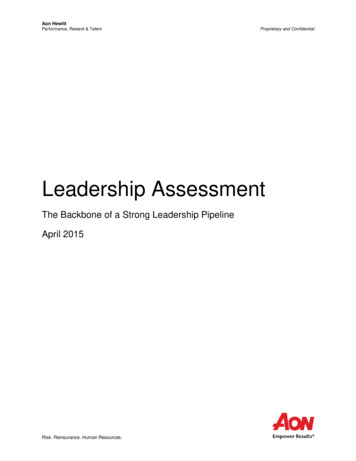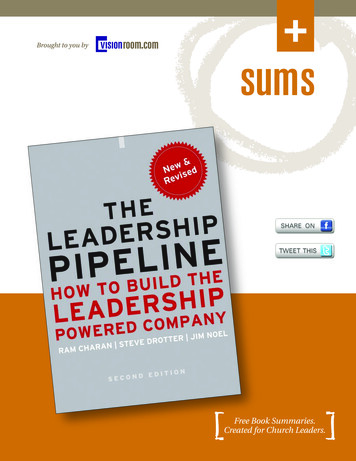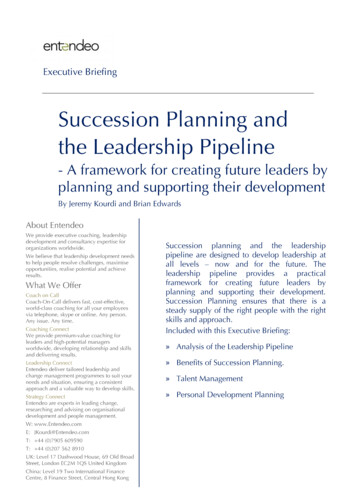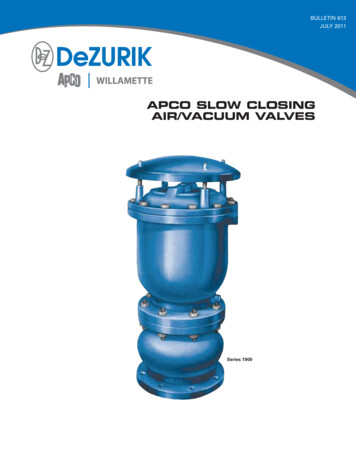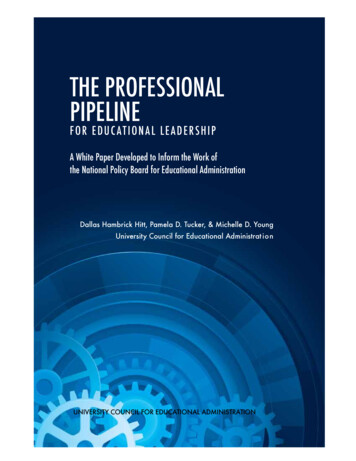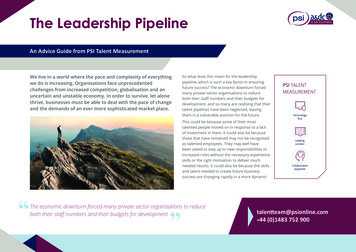
Transcription
The Leadership PipelineAn Advice Guide from PSI Talent MeasurementWe live in a world where the pace and complexity of everythingwe do is increasing. Organisations face unprecedentedchallenges from increased competition, globalisation and anuncertain and unstable economy. In order to survive, let alonethrive, businesses must be able to deal with the pace of changeand the demands of an ever more sophisticated market place.So what does this mean for the leadershippipeline, which is such a key factor in ensuringfuture success? The economic downturn forcedmany private sector organisations to reduceboth their staff numbers and their budgets fordevelopment, and so many are realising that theirtalent pipelines have been neglected, leavingthem in a vulnerable position for the future.This could be because some of their mosttalented people moved on in response to a lackof investment in them. It could also be becausethose that have remained may not be recognisedas talented employees. They may well havebeen asked to step up to new responsibilities orincreased roles without the necessary experience,skills or the right motivation to deliver muchneeded results. It could also be because the skillsand talent needed to create future businesssuccess are changing rapidly in a more dynamicThe economic downturn forced many private sector organisations to reduceboth their staff numbers and their budgets for tiveexpertisetalentteam@psionline.com 44 (0)1483 752 900
An Advice Guide from PSI Talent Measurementenvironment, and there may be a distinct leadership gap that cannot easily bedefined or filled.In this guide we look at what best practice tells us about how to create, developand sustain this vital source of talent in order to boost performance, and preparefor the unpredictable years ahead.Creating the ‘right’ pipelineAccording to an article by John Coleman, published in the Harvard BusinessReview in January 2017 (i), leaders need to have the skills required to run theorganisation today, but must also remain responsive to changing trends in themarket and adapt to meet them. Coleman describes this as: “the ability to holdtwo specific traits in balance: consistency and agility.”Organisations are well aware of the importance of the role of Leadership forbusiness success and the importance of having a strong leadership pipeline.Successful organisations attract talent because they invest in developing theirleaders and become more successful as a result, which in turn makes it easierfor them to attract talent.These organisations devote considerable amounts of time and money todeveloping their leaders and the most successful ones start that process early.Research from the recent CE/Hewlett leadership study (ii) showed that 91% oftop 20 Companies for Leaders have a process for early identification of leaderscompared to 61% of the overall group.Measure the rightelementsSo, if the processes andcommitment are there tocreate and build the pipeline,why do so many organisationsstill find themselves withgaps in their pipeline andwith a scarcity of the requiredleadership characteristics forbusiness success?360 questionnaires areat best a diagnostic tool.What participants do todevelop themselves afterwardsis far more important.The problem seems to bethat what they are aiming athas become a moving target. Businesses need to evolve at an ever faster rateto remain competitive in a tough market. Therefore what they need in terms ofleadership also changes. However, many organisations still recruit, identify andpromote talent on the basis of past performance and competency.A global pharmaceutical organisation encountered significant problemspromoting internal candidates into Site Director roles. In a high proportion of thepromotions, performance dipped significantly within the first year in role and itemerged that individuals were being promoted based on their previous success.The requirements for the Site Director role were not only different from the lesssenior role, but the success criteria had also changed from when the previousincumbent was in post. It was therefore no longer appropriate to promoteagainst track record or to mirror the characteristics of the person in post.
An Advice Guide from PSI Talent MeasurementSo, what is this telling us about our ability to create the right pipeline for ourorganisations’ evolving requirements? Does it mean that it is no longer possibleto predict leadership potential? We at PSI Talent Measurement believe it is amatter of looking broadly across different leadership characteristics and taking amore holistic approach to leadership assessment.In today’s fast changing world, where roles may evolve or disappear, andcompany strategy changes to respond to the changing environment, LearningAgility is set to become one of the most important aspects of leadershipeffectiveness. It is well known, for example, that Microsoft put candidatesthrough a series of tests to assess technical capability and problem solvingskills but also assess how well they interact with other people. In a dynamicenvironment such as theirs a job may easily change or disappear, so theindividual may have to take on a different role in another part of the business.According to research by Professor Bill Joiner, the co-author of ‘Learning Agility’(iii), argues that it is the ability to thrive on change, rather than create stabilitythat will differentiate high from low performance. So what do we mean byLearning Agility? In an article in Forbes Leadership in April 2013, Kevin Cashman(iv) describes Learning Agility as “a complex set of skills that allows us to learnsomething in one situation and apply it in a completely different situation.It is about gathering patterns from one context and then using those patterns ina completely new context. In short, Learning Agility is the ability to learn, adapt,and apply ourselves in constantly morphing conditions.”We have established that assessing your leadership pipeline in a onedimensional way cannot deliver the ‘right’ pipeline in this era of change,dynamism and complexity. If testing for Learning Agility provides us with a richerand more accurate predictor of organisational success, are there otherelements of leadership that contribute to a better and more relevant assessmentof what is needed for future-proofed leadership? Our LIVED model of leadershipincorporates five core elements that are well established as being critical toleadership effectiveness.Get the right ‘fit’However, even this holistic approach to assessing leadership characteristics fallsshort of recognising an important ingredient in establishing the ‘right’ pipeline fororganisational success.To guarantee a strong pipeline of good leadership talent, that can ‘hit the groundrunning’ and deliver business results quickly, there has to be a good ‘fit’ betweenthe individual characteristics and the organisational context as the right sort ofleader in one environment may well struggle if the context changes.Individual leadership qualities therefore need to be ‘right’ for the organisationalculture, the business strategy and the challenges from the externalenvironment at a specific point in time. In this context the identification oftalent using external benchmarks becomes less relevant, and in some casescounterproductive.How useful is it to see how your talent stacks up against different organisationswith different values, culture and business strategies or against data that maybe 10, 15 or 20 years old? What becomes much more important in this contextis the role of the line in making business-driven decisions about the leadershippipeline. Therefore those who are responsible for setting the leadership pipelinestrategy need to stay in close contact with those who are responsible forbusiness strategy and results.
Summary – creating the ‘right’ pipeline Assess your leadership pipeline against a broad and holistic set of leadership elements such as the LIVEDmodel Select criteria that get to the heart of your organisation and what it needs Ensure that there is a good fit between individual characteristics and organisational context Ensure that pipeline decisions stay closely connected to business strategy ‘Future proof’ your selection criteria, by asking does your business need leaders who will replicate what alreadyexists or do you need something different?Charan leadership pipeline modelAn Advice Guide from PSI Talent MeasurementLearningThe ability to adapt to one’sexperiences, make sense ofthem and change in order todeliver better performance.OUR LIVED model of leadership assessmentIntellectThis is one of the most widelyused predictors of leadershipsuccess, particularly inprogressing towards seniorroles. More than justintelligence, this componentof leadership incorporates theability to think strategicallyand commercially.ValuesThis element focuses on integrity, honesty, sincerity, trust and respect andis the basis of what many leadership theorists have described as “character.”It has a solid base in research and is clearly important when it comes torole-modelling desired behaviours and ‘walking the talk’, which manyleaders fail to appreciate.EmotionSince Goleman’s work in the 1990s, it has become increasingly well-known thatthe most effective leaders possess high levels of Emotional Intelligence andthat those with lower levels of EI are more likely to derail when they achieve asenior position.DriveThis is the engagement aspect of leadership, which inspires peopleinto action. It covers passion, self-motivation, resilience and tenacity.Developing the leadership pipelineEstablishing the right criteria for your leadership pipelinewill help you identify potential, but get the timing or thetype of development intervention wrong, and your pipelinewill be full of unfulfilled promise or gaps which will needto be filled by turning to the external market. Best practiceorganisations grow their pipelines from within, and manyorganisations use the well-documented Charan and DrotterLeadership Pipeline model which identifies six critical‘passages’ when leaders need to learn new skills and adaptto different and more complex challenges.Developing the leadershippipelineThe existence of these ‘passages’ means that organisationsneed to provide targeted, specific development inEstablishingtheforrightcriteriaforyourthe risk ofpreparationeach passagein orderto reduceleaders failing in their new roles.leadershippipeline will help you identifypotential, but get the timing or the typeAccelerateinterventiondevelopment inpreparationof developmentwrong,andfornewrolesyour pipeline will be full of unfulfilledis how to best accelerate developmentpromiseTheorquestiongapsthen,whichwill need to be filledin preparation for those vital transitions? Research byPrincetonUniversityfor their 70/20/10v modelsuggestsby turningtotheexternalmarket.Bestthat 70% of learning and development takes place 0%practice organisations grow their pipelinescomes from feedback and from observing and working withrole modelsandmanyonly 10%organisationsof learning and developmentfrom within,andusecomes from formal training.the well-documented Charan and DrotterLeadership Pipeline model which identifies sixcritical ‘passages’ when leaders need to learnnew skills and adapt to different and morecomplex challenges.The existence of these ‘passages’ meansthat organisations need to provide targeted,specific development in preparation for eachpassage in order to reduce the risk of leaders failing in their new roles.Accelerate development in preparation for new roles The question then,is how to best accelerate development in preparation for those vital transitions?Research by Princeton University for their 70/20/10 v model suggests that 2017. The a&dc Group. For more information call us on 44 (0)1483 752 900 or visit www.adc.uk.com/resources for additional resources.70% of learning and development takes place from on-the-job experiences,tasks and problem solving, 20% comes from feedback and from observing andworking with role models and only 10% of learning and development comesfrom formal training.4
An Advice Guide from PSI Talent MeasurementProvide the best opportunities for accelerateddevelopmentOrganisations need to create development opportunities that combine formaltraining with initiatives that mirror the ‘step up’ role and provide real experienceswith minimal risk to the business. The organisations that follow best practicedon’t just focus on vertical career moves to upskill their future leaders. Theyalso provide the necessary experience for them by offering lateral moves toroles which involve different challenges or more complexity but which are at thesame grade, by allowing future leaders to work on initiatives that require themto work across boundaries or functions and by offering secondments to otherroles. This requires a move away from the traditional way of thinking that careeradvancement can only be achieved by upward moves.The opportunity to learnfrom mistakes whilst gainingexperience in a lower riskenvironment is an essentialelement .It also addresses anotherchallenge for organisationsduring tough times wherethere are fewer opportunitiesfor vertical progression, andengaging and retaining talentrequires a more creativeapproach. The latest reportfrom the Centre for CreativeLeadership on ‘the View fromInside the Leadership Pipeline’(vi) indicates that high potentialleaders are more committedand engaged when they have a clear career path, and they understand nextsteps in terms of moves, development and experience. The opportunity tolearn from mistakes whilst gaining experience in a lower risk environment is anessential element of motivating and engaging your leadership pipeline.Leaders should develop leadersThe same report also highlights the importance of senior stakeholders indeveloping and engaging the leadership pipeline.Those organisations that have a strong ‘Leadership Brand’ have a reputationfor investing in their talent, and therefore attract talent to their pipeline.This investment is both financial and practical. There is solid evidence nowdemonstrating the correlation between financial investment in talent andbusiness performance. The argument for practical investment from the leadersof leaders is less well understood and much less well practised.At a recent Talent Management Forum a leading figure from one of the world’slargest mobile phone operators made this plea: “We need to move away fromprocess and get back to having real conversations with our people”. Leadersplay a critical role in developing other leaders, and they need to have the rightconversations at the right time and in the right places. Organisations needto ensure that honest and open communication is part of their culture. Highpotential leaders want an honest assessment of where they stand and clarityabout their position in the leadership pipeline. Their seniors therefore need to beprepared to provide not only accurate feedback, but also longer-term guidancein order to map out successful career paths for their talent. Of course, manysenior leaders are more used to conducting performance conversations than
An Advice Guide from PSI Talent Measurementdevelopment conversations and will therefore need support and training inorder to feel confident and motivated to take on what is more of a coaching andmentoring role.We are approaching an era in which it will be commonplace for there to bethree generations working within an organisation. As demographics changeand as legislation is introduced to encourage employees to work for longer,organisations will need to understand the needs, skills and aspirations of anolder workforce. Age diversity within business will bring with it many challenges,but also great opportunity. For example, the career aspirations and motivationsof more seasoned leaders are likely to alter, and creative solutions will berequired to make the most of their knowledge and experience. Mentoring andcoaching younger aspiring leaders or talent is an obvious and valuable role forthose with significant technical and leadership experience. They can providemuch-needed development resource to increase the size of their organisations’talent pools and to accelerate progress.Broaden your talent pipelineWhen times get tough, it is easy to see why organisations are tempted toreduce their investment in leadership pipelines. But even in periods of growth,do organisations invest broadly enough to guarantee a robust and healthypipeline? High potentials should and do expect a higher degree of supportand development than those who are not in the formally recognised pipeline.Investment decisions, however, should not ignore the wider pool, as this lesshigh profile population will undoubtedly contain future leadership contenders.For example, Grundfos, one of the world’s leading pump manufacturers, developtheir leadership pipeline by identifying two talent pools - their ‘global’ talents butalso what they describe as ‘local’ talents. These are talented employees who cando a great job for them as a technical expert or as a leader within their existingmarket, but who do not aspire to more strategic or global roles.Organisations ignore emerging talent at their peril, and can and should developspecific development programmes for those who have not yet gained theexperience or skill to be classified as ‘top talent’. If formal investment in thedevelopment of this group is a step too far, then informal development canprovide a valuable alternative. 84% of the high potentials surveyed in CCL’sLeadership Pipeline report said that they were actively engaged in identifyingand developing potential in others because they had the insight and experienceto develop the next layer of talent. Organisations should support this type ofinitiative as it will create a wider pool of individuals who have the potential to fillthe narrower and more select leadership pipeline.Change is the new constant in our unpredictable and uncertain world.It has never been more important to invest in creating a leadership pipelinethat provides a rich source of talent equipped to deal with any eventuality.It is more important than ever to make the right decisions about where toinvest for maximum return, and to ensure that your talent programmes keepevolving to match the pace of change.
An Advice Guide from PSI Talent MeasurementSummary – Developing the leadership pipeline Wherever possible, grow the pipeline from within. Identify the key stages of transition for your leaders and providedevelopment to help them to prepare for these transitions. Combine formal training with a heavy emphasis on real work experiencesto consolidate skill acquisition. Create a culture in which senior leaders are expected to help developfuture leaders. Invest in the pipeline but don’t ignore the wider talent pool. Create a variety of different career pathways to keep those who are in thepipeline engaged and committed.
References:1) The Best Strategic Leaders Balance Agility and Consistency John Coleman, (Harvard Business Review, January 2017)2) Leadership Study - CE/Hewlett3) Leadership Agility –Dr Bill Joiner4) The Five Dimensions Of Learning-Agile Leaders Kevin Cashman (Forbes Leadership, April 2013) v PrincetonUniversity Learning Process5) A View From Inside The Leadership Pipeline –Michael Campbell and Roland Smith (CCL)About PSI Talent MeasurementPSI Talent Measurement solutions enable organisations toidentify and select the highest performing human capitalacross the widest range of job roles. Our unique blend ofscientifically proven assessment content, market leadingtechnology and our extensive knowledge and expertise,ensure we deliver selection methods that drive individualand organisational effectiveness.In June 2017, a&dc (a PSI business) was acquired by PSIServices LLC, joining forces to deliver innovative assessmentcontent using world leading technology.PSI Talent Measurement3 Onslow Street, Guildford, Surrey GU1 4SY 44 (0)1483 752 900 talentteam@psionline.comadc.uk.com 2018 a&dc - a PSI business.
This is the engagement aspect of leadership, which inspires people into action. It covers passion, self-motivation, resilience and tenacity. Developing the leadership pipeline Establishing the right criteria for your leadership pipeline will help you identify potential, but get the timing or the type of development intervention wrong, and

